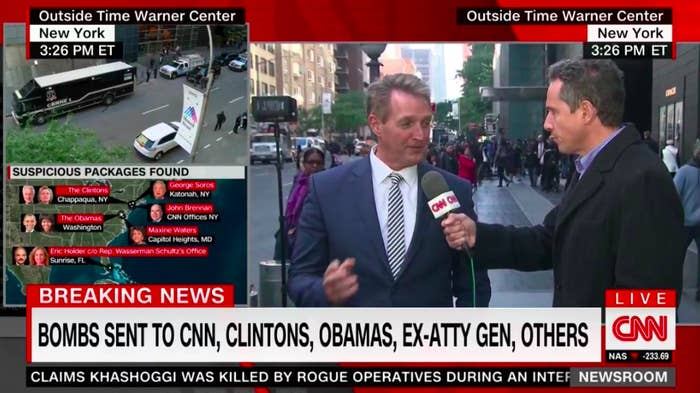
It’s become routine these days to hear people describe the churning cycle of politics and news, tossed back and forth between Twitter, Facebook, YouTube, comments sections, and television, as “broken.” You can feel the nation’s blood pressure rising as the election approaches, and the specter of political violence gets closer and closer. But this isn’t a broken system: There’s order to the madness. In fact, what feels broken is the product of a well-oiled machine in which all participants seem to know their specific roles.
The end result is a near-perfect union of many of the darkest forces in American culture — the collision of toxic hyperpartisanship, sensationalized media, and a mature online ecosystem that seems to incentivize and accelerate the worst impulses and behaviors. And if the past is any indication of future performance, it will only get worse. The machine is not broken, it’s firing on all cylinders.
That’s why, within minutes of Wednesday morning’s reports that suspicious explosive devices had been mailed to well-known Democrats like former president Barack Obama and Bill and Hillary Clinton, far-right media personalities reflexively mused that the packages were a “false flag” attempt to solicit goodwill for Democrats two weeks before the midterms. That dozens of pro-Trump commentators and personalities settled on this narrative at once is not a coincidence or a conspiracy. It’s far simpler: Crying “false flag” is a tried and true tactic. And for an audience eager to dismiss anything that will challenge their preexisting ideologies, it’s effective.



That’s why this conspiratorial mindset has bled from the murky fringes of the internet into the political rhetoric. Because it works! Alex Jones and his Infowars media empire not only provided a blueprint for reflexive conspiracy theorizing but laid the foundation for the efficient transmission of these ideas across social platforms (before, of course, getting banned from them this summer). Jones’ popularity and his success at cultivating audiences touting baseless claims and incendiary rhetoric wasn’t just good entertainment, but proof of concept good enough to rewire a segment of political discourse and launch dozens of copycats (and not just on the right; the temptation of the Russia/Mueller story, for instance, has produced its fair share of Blue Detectives, too).
Because this has all happened before, the politicians know their respective roles, too. They make pleas for civility — saying that our heated political debating has gone too far. They call for unity. They disavow political violence. And some assign blame to a president who has chosen the media as a target. The president then ignores those voices and blames the media for its role in the anger and partisanship in today’s society. None of these individual positions plays well with their respective political opponents, but each is received with encouraging shouts of approval from the base.
Which brings us to the press, which, of course, knows its role. It’s why journalists and news organizations adopted the indignant posture of the righteous victim. It’s why reporters doubled down on fact-checking and calling attention to countless falsehoods coming from Trump rallies. It’s the reason CNN defiantly shot its Wednesday broadcasts from a New York City sidewalk after a bomb threat evacuated their Manhattan headquarters. Signaling the virtue of reporting and speaking truth to power isn’t just a way to maintain accountability or to defend the dignity of one’s profession from a political movement that seeks to devalue it — it’s also a way to win public approval. And, in some cases, it also makes for good TV. This resolute posture plays well with the base (in this case, those who value reporting), but only further angers those who see the press as dangerous soldiers in an information war.
God help us all
The partisans and the press aren’t the only patsies here. The tech platforms acting as particle accelerators for the hourly news cycles know their role as well. They are the connective tissue for the entire ecosystem, whose algorithms are carefully calibrated to reward information that is often misleading and polarizing. Vulnerable to propaganda and misinformation, the systems unwittingly make conspiracy theories easier to find, as Twitter did on Wednesday when its algorithms surfaced #FAKEBOMBSCARE, #FakeBombs, and #FalseFlag tweets in its Trending module.
And, when their rules are inevitably violated, tech platforms’ inaction and begrudging corrections have become predictable, too. Like on Thursday, when Instagram refused to take down a post by troll Milo Yiannopoulos lamenting that the mail bombs didn’t go off. According to Instagram, the post did not violate its terms of service. But, predictably, a few hours after a story on the post caused outrage online, the platform quickly removed it.
aaand scene.
None of this happens in a vacuum. Each group’s actions both result from and provoke the actions of the other groups. The media’s righteous indignation at Trump’s attack on the press only feeds Trump and his supporters’ claim of a biased press. Claims of false flags from the far right are further proof for anti-Trumpers of a bankrupt and unhinged pro-Trump media fringe. Conversely, for the far right, the left’s dismissal of their conspiracy theories suggests that they’re onto something. The tech platforms’ failure to enforce its rules and stop divisive misinformation is proof to some of a dangerous monopoly, while others see any enforcement from the Facebooks and Twitters of the world as proof of corporate tyranny. The dance has become so rote that even extremely online civilians can become effective propaganda outlets (one look at the alleged mail bomber’s meme-plastered van reveals an individual all too familiar with the the particulars of online message board–powered information warfare).
This is the machine at work. And, until someone finds a way to break the cycle, it will only get worse. Because everyone knows their roles, with each cycle the machine becomes slightly more efficient. Each action inspires an equal and opposite toxic reaction with just a bit less friction. The cumulative effect of each cycle helps to cobble together two separate universes, each armed with its own set of facts. Everybody is losing and but feels like they’re winning, all at the same time.
